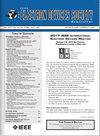Optimization of Guard Ring Structures for Superior Dark Current Reduction and Improved Quantum Efficiency in InGaAs/InP APDs
IF 2.4
3区 工程技术
Q3 ENGINEERING, ELECTRICAL & ELECTRONIC
引用次数: 0
Abstract
Avalanche photodiodes (APDs) based on InGaAs/InP are pivotal for applications in low-light detection, yet their performance is often hindered by edge breakdown and high dark currents. This study systematically optimizes guard ring structures to address these challenges, focusing on attached guard rings (AGRs) and floating guard rings (FGRs) through a synergistic approach combining simulation-guided design, fabrication, and experimental validation. We analyze the impact of Zn diffusion depth, AGR/FGR geometries, and electric field distribution on device performance. Experimental results demonstrate that optimized AGR structures reduce dark currents by 70% and enhance quantum efficiency (QE) by 43%, while FGR structures achieve an order-of-magnitude reduction in dark current and a 90% QE improvement compared to non-guarded devices. The breakdown voltage increases by 2.5 V (AGR) and 4 V (FGR), leading to enhanced gain. These advancements highlight the critical role of guard ring optimization in effectively mitigating edge breakdown, offering a pathway to high-sensitivity InGaAs/InP APDs for photon detection technologies.InGaAs/InP apd中保护环结构的优化及暗电流减小和量子效率的提高
基于InGaAs/InP的雪崩光电二极管(apd)在低光检测应用中至关重要,但其性能经常受到边缘击穿和高暗电流的阻碍。本研究系统地优化了保护环结构以应对这些挑战,重点研究了附着保护环(agr)和浮动保护环(fgr),通过结合仿真指导设计、制造和实验验证的协同方法。我们分析了锌扩散深度、AGR/FGR几何形状和电场分布对器件性能的影响。实验结果表明,优化后的AGR结构减少了70%的暗电流,提高了43%的量子效率(QE),而FGR结构与非保护器件相比,暗电流减少了一个数量级,量子效率提高了90%。击穿电压增加2.5 V (AGR)和4 V (FGR),导致增益增强。这些进展突出了保护环优化在有效减轻边缘击穿方面的关键作用,为光子探测技术的高灵敏度InGaAs/InP apd提供了一条途径。
本文章由计算机程序翻译,如有差异,请以英文原文为准。
求助全文
约1分钟内获得全文
求助全文
来源期刊

IEEE Journal of the Electron Devices Society
Biochemistry, Genetics and Molecular Biology-Biotechnology
CiteScore
5.20
自引率
4.30%
发文量
124
审稿时长
9 weeks
期刊介绍:
The IEEE Journal of the Electron Devices Society (J-EDS) is an open-access, fully electronic scientific journal publishing papers ranging from fundamental to applied research that are scientifically rigorous and relevant to electron devices. The J-EDS publishes original and significant contributions relating to the theory, modelling, design, performance, and reliability of electron and ion integrated circuit devices and interconnects, involving insulators, metals, organic materials, micro-plasmas, semiconductors, quantum-effect structures, vacuum devices, and emerging materials with applications in bioelectronics, biomedical electronics, computation, communications, displays, microelectromechanics, imaging, micro-actuators, nanodevices, optoelectronics, photovoltaics, power IC''s, and micro-sensors. Tutorial and review papers on these subjects are, also, published. And, occasionally special issues with a collection of papers on particular areas in more depth and breadth are, also, published. J-EDS publishes all papers that are judged to be technically valid and original.
 求助内容:
求助内容: 应助结果提醒方式:
应助结果提醒方式:


